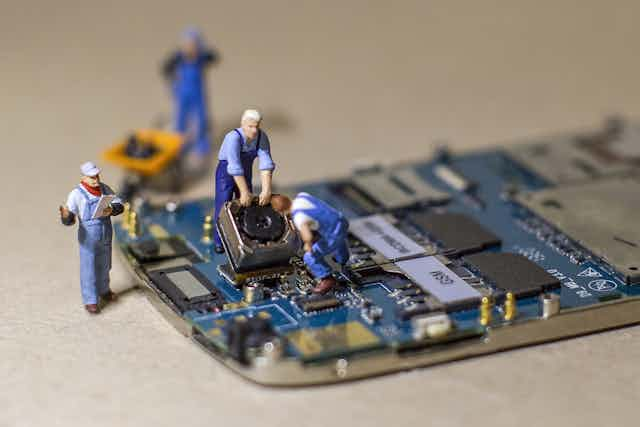Traditionally, when a car breaks down, the solution has been to fix it. Repair manuals, knowledgeable mechanics and auto parts stores make car repairs common, quick and relatively inexpensive. Even with modern computer-equipped vehicles, regular people have plenty they can do: change oil, change tires and many more advanced upgrades.
But when a computer or smartphone breaks, it’s hard to get it fixed, and much more common to throw the broken device away. Even small electronic devices can add up to massive amounts of electronic waste – between 20 million and 50 million metric tons of electronic devices every year, worldwide. Some of this waste is recycled, but most – including components involving lead and mercury – goes into landfills.
Bigger equipment can be just as difficult to repair. Today’s farmers often can’t fix the computers running their tractors, because manufacturers claim that farmers don’t actually own them. Companies argue that specialized software running tractors and other machines is protected by copyright and patent laws, and allowing farmers access to it would harm the companies’ intellectual property rights.
Users’ right to repair – or to pay others to fix – objects they own is in jeopardy. However, in our surveys and examinations of product life cycles, my colleagues and I are finding that supporting people who want to repair and reuse their broken devices can yield benefits – including profits – for electronics manufacturers.
A corporate quandary
At least eight states – Nebraska, Kansas, Wyoming, Illinois, Massachusetts, Minnesota, New York and Tennessee – are considering laws that would require companies to let customers fix their broken electronics. The proposals typically make manufacturers sell parts, publish repair manuals and make available diagnostic tools, such as scanning devices that identify sources of malfunctions. In an encouraging move, the U.S. Copyright Office suggested in June that similar rules should apply nationwide. And the U.S. Supreme Court recently ruled that companies’ patent rights don’t prevent people from reselling their electronics privately.
Seen one way, these regulations put manufacturing companies in a tough spot. Manufacturers can earn a lot of money from selling authorized parts and service. Yet to remain competitive, they must constantly innovate and develop new products. To keep costs down, they can’t keep making and stocking parts for old and outdated devices forever. This leads to what’s called “planned obsolescence,” the principle that a company designs its items to have relatively short useful lives, which will end roughly around the time a new version of the product comes out.
However, our research suggests that companies can take a different approach – designing and building products that can be refurbished and repaired for reuse – while building customer loyalty and brand awareness. By analyzing surveys of hobbyists and the repair industry, we’ve also found that there are barriers, such as a lack of repair manuals and spare parts, that impede the growth of the repair industry that can be improved upon.
Consumers want to fix their devices
Even as machines and devices have become less mechanical and more electronic, we have found that customers still expect to be able to repair and continue using electronic products they purchase. When manufacturers support that expectation, by offering repair manuals, spare parts and other guidance on how to fix their products, they build customer loyalty.
Specifically, we found that customers are more likely to buy additional products from that manufacturer, and are more likely to recommend that manufacturer’s product to friends. The math here is simple: More customers using a company’s products, whether brand-new or still kicking after many years, equals more money for the business.
Our research also shows that the failure of most electronic devices is due to simple accidents such as dropping a device or spilling water on it. The most common problem is a broken screen. There are other issues, too – such as batteries that no longer hold their charges or circuit boards that just stop working.

Even nontechnical users often want to pay someone to clean their devices and replace parts such as damaged screens and old batteries. If manufacturers provided access to replacement parts, more damaged items could be repaired, extending their usefulness. Apple could seize an opportunity here: It has just begun assembling older iPhone models in India, which means it is still making parts that others could use to fix the devices they already have.
Helping consumers, companies and the environment
Technology manufacturers should take steps to promote customers’ right to repair their broken devices, which helps cut down on electronic waste and boost brand loyalty. But if they won’t, laws and regulations can help.
In France, for example, a 2015 law requires manufacturers to tell customers – before they purchase an item – for how long repair parts will be available. That lets consumers decide how much they want to factor in the possibility for repairs when deciding whether to buy something new.
Supporting repair rights can also bring economic benefits to more than just the technology sector. There were 4,623 consumer electronic repair and maintenance companies in 1998 in the U.S. By 2015, that number had dropped to 2,072. Independent vendors are creating online marketplaces where people can buy and sell used and repaired gadgets. Other companies like iFixit and Repair Cafe are creating networks of people who share information on repairing electronics, and even getting groups of people together in person to work on their devices.
Meanwhile 3-D printing continues to make it easier and cheaper for people to produce replacement parts for older devices.
Companies shouldn’t fear people taking too much into their own hands, though: While it’s been possible for a few years to 3-D print and hand-assemble entire computers, they’re not very good. People are much more likely to buy corporate-made devices; they just want to be able to repair them when they break down.

